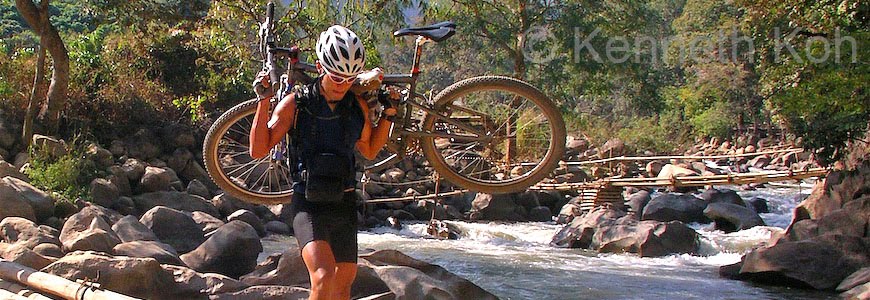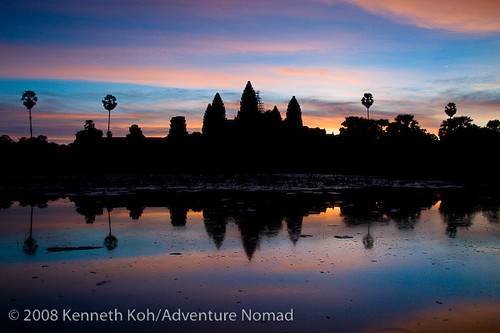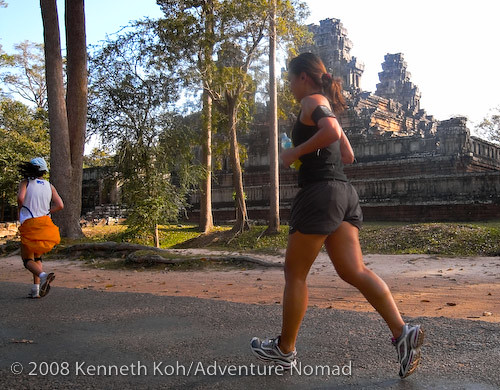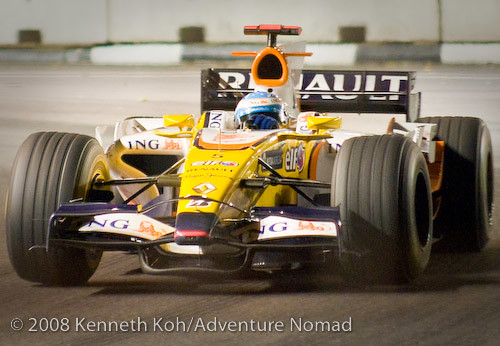 Joe touring in Tibet. Joe was racing his mountain bike in Asia, otherwise he would have used his LHT. Image courtesy of Joe Cruz.
Joe touring in Tibet. Joe was racing his mountain bike in Asia, otherwise he would have used his LHT. Image courtesy of Joe Cruz.
I put down a deposit on a
Surly Long Haul Trucker last week using the settlement that the insurance company paid me following my
bike accident earlier this year. Since I didn’t know anything about touring bikes, I did the logical thing and asked for help in choosing a bike. My thanks to all the guys who took the time to answer my questions. *
 Joe Cruz racing cyclocross. Image courtesy of Joe Cruz.
Joe Cruz racing cyclocross. Image courtesy of Joe Cruz.
I’ve been in touch with Joe Cruz, a faculty member at the prestigious William’s College in Massachusetts and a very experienced, hardcore adventure bike tourer, over the past few weeks. Joe had this to say about the Surly LHT:
“When I started to plan longer and more serious trips and decided to invest in a dedicated bike, I did what we all do in buying gear. I tried to balance cost and my best info about durability and appropriateness for my needs, and I didn't go in thinking that I could find the absolutely perfect bike.”
“An adventure bike needs to be the following things:
- Versatile. I want to be comfortable pedaling for ten hours on asphalt, gravel or dirt, day after day; I want to be able to mount slicks and go on a training ride with the local road club when I'm far from home; I want to be able to ride pretty demanding singletrack; I want to be able to ride with panniers; at home, I want to a bike that might be decent on grocery runs. In practice, a bike is probably going to be good at a small number these things, but I want to be able to do them all and have the bike be at least reasonably up to it.
- Easy to ride. The geometry needs to be such that it doesn't take much vigilance from me to pilot. There are going to be times when I am at 17,000 feet, bonked, cold, and in the dark. My bike can't be yet another challenge. The thing is, I also want to be able to go fast on flat paved roads, or twisty road descents. And I want the bike to have good enough manners off-road. And when I'm in really dense urban areas, I want to be able to see traffic and be maneuverable.
- Durable. Basically I don't want to even think about the fragility of the bike. I'm not totally convinced that an aluminum frame is wrong for adventure touring, but if there is even a slight chance that I'll need someone to weld the thing while on the road, I don't want the option excluded. More realistically, if the derailleur hanger or the fork or whatever get bent, I want to just bend them back (within reason).
- Not overly precious or prissy. The bike is going to get roped to the roof of buses and the back of pack mules, clipped to a steel basket for a gorge crossing, or tossed in the bucket of an empty dump truck. I want to be able to shrug off the inevitable dents or nicks. Some airlines still allow you to check the bike unboxed. When it's an option, I want to be able to do that without caring that it might get scratched.
- Not have cost me a lot. The bike could get lost or stolen, and I don't want to be devastated. This is going to be relative, of course, but, for me, certainly under US$2000, while under US$1500 would be even better.
- Repairable on the road, all over the world. Stuff is going to break, and I want to be able to substitute and improvise with what is available to me locally until I can have specialized gear shipped.
 Joe's Surly LHT: ruggedly equipped with cross brakes, downtube shifters and knobby tires. Image courtesy of Joe Cruz.
Joe's Surly LHT: ruggedly equipped with cross brakes, downtube shifters and knobby tires. Image courtesy of Joe Cruz.
Given this wish list, I have not found anything better than the LHT. I've ridden it with panniers in Asia, Europe, Mexico, and, of course, at home in the US. I've raced it in mountain bike races (not my first or even second choice, but it happened) and on frozen lakes with Hakkapelitas. It goes along pretty good with slicks when I'm in the drops, I can mount 2.35 Nevegals on it for offroad, and on most tours running Marathon cross 1.5's is good enough for anything resembling a road or dirt path. On singletrack the bb is a little low for log hops, but riding the tops makes a lot of stuff surprisingly doable (I have top bar levers that you sometimes see on 'cross bikes, though I don't run them on my actual 'cross bike). If someone said that I could keep only one of my bikes, this one would be it.
Are there other bikes that could do these things? Yeah, probably. But some popular choices fall short for me. Thorns are a fair bit more expensive, and I have no interest in Rohloff hubs (heavy, their durability seems overstated, and junky but serviceable derailleurs are readily available to run with shifters in friction mode). I don't have any reliable info on how big a tire can be mounted on the Dawes offerings. The Rivendell Atlantis is a gorgeous bike, but that's also a downside. Some continental bikes look pretty good, but the Koga-Miyata's, for instance, are aluminum. And then anything with an integrated rack won't do for me when I want to take all the heavy stuff off and just go riding wherever I am. There are definitely steel mountain bikes that can be converted to adventure use, but they would have to have long chain stays for pannier heel clearance, couldn't be too flexy, and need a long headtube for drop bars (I've done long tours on flat bars and I don't care that much about not having the much ballyhooed multiple hand positions. But I like drops for going fast.)
What about the Salsa Fargo? I totally want one for riding here in the US. But as far as winning the adventure bike prize, the Fargo's wheel size is basically a deal breaker for me. My main endurance race bike is a singlespeed 29er, and I'm not looking back to 26ers as far as mountain biking goes. For better or for worse, though, the wheel size that came to be the American standard for mountain bikes in the 80's is now the most widely available around the world. Sure, a well build wheel isn't likely to implode, but in the overall scheme of bicycle components, the wheels are a worrisome blend of fragile/difficult-to-improvise/showstopper-if-you-don't-have-it. Moreover, though tires can be booted and stitched together, there is some wear and damage that just can't be readily managed.
You sometimes hear people say that in this era of global access to consumer goods, you can just have a wheel or a tire shipped to you wherever you are. There's something to that, but I've seen tires in shops and stalls in towns that don't have phones, let alone Internet. For a lot of places that I want to ride, there's a much higher premium placed by locals on the availability of bike tires than on having a post office.
 Joe is currently touring in SE Asia. Here's his packed LHT. Image courtesy of Joe Cruz.
Joe is currently touring in SE Asia. Here's his packed LHT. Image courtesy of Joe Cruz.
Other thoughts:
- If I was too tall to ride a 54 or smaller LHT, then I guess I'd convert an old mountain bike for adventure use.
(note from me: LHTs in sizes 56 and larger use 700c wheels)
- What's my real basis for comparison? I've toured on a converted 1989 Wicked Fat Chance with rear panniers (West Coast of USA), a Santa Cruz Superlight pulling an Extrawheel trailer (Pakistan, India, Nepal, Tibet), a Karate Monkey with rear panniers (East Coast of USA), an 80's Bianchi steel road racing bike with a large Carradice seat post bag (USA, UK, China), a recent vintage Felt aluminum/carbon fiber race bike with seatpost bag (East Coast of USA, France), and a Bike Friday folding bike pulling its suitcase (East Coast of USA, Ireland, France, Spain). None of those were catastrophes. Indeed, the Superlight -- in spite of being absolutely wrong by every bit of conventional wisdom -- was probably the best. Of course, I was fortunate that neither the rear shock nor the suspension fork had any problems. The LHT is better than all of these.” **
“The LHT has the edge in that it gives you the peace of mind of knowing that nothing fancy is going to break, and that you can get into the drops and go fast into a headwind if you need to get somewhere. It's my go-to bike for all adventures now.”
* My thanks to Joe Cruz, Al Downie, Alvin Lee, Jeff Palmer and Dave Snowberg for the taking time to answer all my questions.
** Reprinted with permission from Joe’s post to the MTBR.com forum
The Surly Long Haul Trucker is available for SGD$1800 in Singapore at
T.R. Bikes.
 Sunset at Phnom Bakheng, Siem Reap. Nikon D300, 18-200mm, Program mode at -1 EV, 1/500 f/11, ISO 800.
Sunset at Phnom Bakheng, Siem Reap. Nikon D300, 18-200mm, Program mode at -1 EV, 1/500 f/11, ISO 800. Catch of the Day. Shot just after sunrise at a fishing village near Siem Reap. Nikon D300, 10.5mm Fisheye, Program Mode at -1/3 EV, 1/250 f/3.5, ISO 200, pop-up flash with 1/4 CTO gel at -1 FEV.
Catch of the Day. Shot just after sunrise at a fishing village near Siem Reap. Nikon D300, 10.5mm Fisheye, Program Mode at -1/3 EV, 1/250 f/3.5, ISO 200, pop-up flash with 1/4 CTO gel at -1 FEV. A visitor examines the prisoners quarters at Tuol Sleng. Nikon D300, 18-200mm, Program Mode at -1/3 EV, 1/50 f/3.5, ISO 1600. B&W conversion done in Lightroom.
A visitor examines the prisoners quarters at Tuol Sleng. Nikon D300, 18-200mm, Program Mode at -1/3 EV, 1/50 f/3.5, ISO 1600. B&W conversion done in Lightroom. Angkor Wat, in silhouette at Sunrise. Nikon D300, 18-200mm, manually exposed at 1/60 f/8, ISO 200, Slik Sprint Mini Tripod with RRS BH-25 Ballhead, graduated filter applied in post processing.
Angkor Wat, in silhouette at Sunrise. Nikon D300, 18-200mm, manually exposed at 1/60 f/8, ISO 200, Slik Sprint Mini Tripod with RRS BH-25 Ballhead, graduated filter applied in post processing. MTV Exit Live in Concert at Angkor Wat. Nikon D300, 18-200mm, Aperture Priority at 1/25 f/4.2, ISO 2000.
MTV Exit Live in Concert at Angkor Wat. Nikon D300, 18-200mm, Aperture Priority at 1/25 f/4.2, ISO 2000.
































.jpg)














